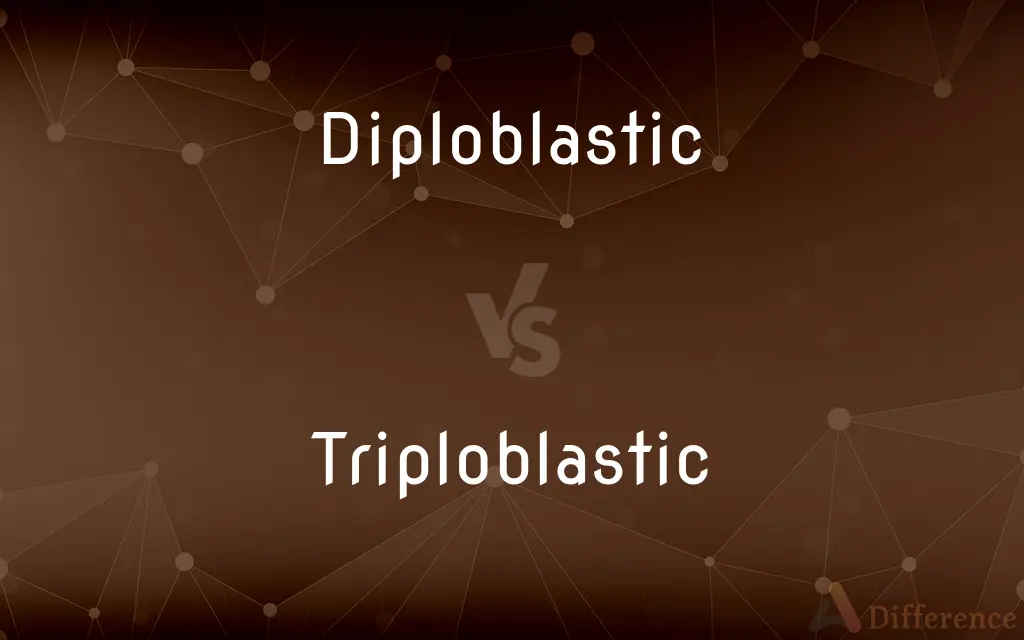Diploblastic vs. Triploblastic — What's the Difference?
By Urooj Arif & Fiza Rafique — Updated on March 14, 2024
Diploblastic organisms have two primary tissue layers, while triploblastic organisms have three.

Difference Between Diploblastic and Triploblastic
Table of Contents
ADVERTISEMENT
Key Differences
Diploblastic organisms, such as jellyfish and corals, are characterized by having two primary layers of tissues: the ectoderm (outer layer) and the endoderm (inner layer). These layers give rise to the skin and internal linings, respectively. Between these layers is a gelatinous substance called mesoglea. In contrast, triploblastic organisms, which include most animals like humans, insects, and worms, possess an additional layer called the mesoderm, situated between the ectoderm and endoderm.
The presence of the mesoderm in triploblastic organisms allows for the development of more complex structures and systems, including muscles, circulatory systems, and more advanced organs. This complexity enables a wider range of functions and adaptations, facilitating diverse lifestyles and behaviors. Diploblastic organisms, with their simpler structure, are generally limited to more basic functions and forms, often leading to a sessile or planktonic lifestyle.
The distinction between diploblastic and triploblastic organisms extends beyond their tissue layers to their overall complexity and evolutionary capabilities. Triploblastic organisms, thanks to their additional layer, can develop specialized organs and systems, allowing for greater mobility, more complex behaviors, and a wider variety of ecological niches. Diploblastic organisms, while simpler, exhibit a range of body forms and reproductive strategies that have allowed them to thrive in numerous aquatic environments.
Embryonic development in these organisms also differs. In diploblastic organisms, the embryo develops two germ layers, leading to a more straightforward body plan. In triploblastic organisms, the development of the mesoderm adds complexity to the embryonic development, resulting in a more intricate body plan and the possibility of forming a body cavity, or coelom, which can further increase complexity and specialization.
Both diploblastic and triploblastic organisms play crucial roles in their respective ecosystems. Diploblastic organisms, like corals, can form extensive reef systems that provide habitats for numerous other species. Triploblastic organisms, with their greater complexity, often occupy key positions in food webs and contribute to the biodiversity and functionality of their ecosystems.
ADVERTISEMENT
Comparison Chart
Tissue Layers
Two: ectoderm and endoderm
Three: ectoderm, mesoderm, and endoderm
Complexity
Generally simpler structures and systems
More complex structures and systems
Body Plans
Limited complexity, often sessile or planktonic
More diverse, including mobile forms
Mesoglea
Present, gelatinous substance between layers
Absent, replaced by mesoderm
Organ Development
Limited to simpler organs
Allows for more complex organs and systems
Compare with Definitions
Diploblastic
Diploblastic organisms have an ectoderm and endoderm.
Jellyfish have a simple body plan with two main layers.
Triploblastic
Capable of developing advanced organs and systems.
Earthworms have muscular and digestive systems due to their triploblastic nature.
Diploblastic
They exhibit simpler anatomical structures.
Corals, with their basic form, are diploblastic.
Triploblastic
Triploblastic organisms have an ectoderm, mesoderm, and endoderm.
Humans have complex systems thanks to these layers.
Diploblastic
Primarily found in aquatic settings.
Most diploblastic organisms, like certain jellyfish, thrive in oceans.
Triploblastic
Can inhabit a wide range of environments.
Triploblastic organisms like insects are found from deserts to forests.
Diploblastic
A gelatinous substance between the two layers.
The mesoglea in sea anemones provides structural support.
Triploblastic
Supports a range of behaviors and adaptations.
Birds, with their flight adaptations, are triploblastic.
Diploblastic
Fewer and simpler organs due to two layers.
Hydra have a simple digestive cavity without complex organs.
Triploblastic
The mesoderm allows for greater structural and functional diversity.
The presence of a mesoderm in mammals leads to the development of complex organs.
Diploblastic
Having body tissues derived from only two germ layers, the endoderm and the ectoderm, as in the cnidarians.
Triploblastic
Having body tissues derived from three germ layers, the endoderm, mesoderm, and ectoderm, seen in all multicellular animals except certain invertebrates such as the cnidarians and sponges.
Diploblastic
(biology) Having two embryonic germ layers (the ectoderm and the endoderm)
Triploblastic
Exhibiting triploblasty
Diploblastic
Characterizing the ovum when it has two primary germinal layers.
Triploblastic
Of, pertaining to, or designating, that condition of the ovum in which there are three primary germinal layers, or in which the blastoderm splits into three layers.
Common Curiosities
Are all animals either diploblastic or triploblastic?
Most animals fit into these categories, with triploblastic being more common in diverse and complex species.
Can diploblastic organisms form complex organs?
Generally, no; their simpler body plan limits organ complexity.
Do diploblastic organisms have a body cavity?
No, the simplicity of their body plan typically does not include a true body cavity.
What is unique about triploblastic organisms?
They have an additional tissue layer, the mesoderm, allowing for more complex structures.
How does the mesoderm influence triploblastic organisms?
It enables the development of muscles, circulatory systems, and more intricate organs.
Do all triploblastic organisms have a coelom?
Not all; triploblasts can be acoelomate, pseudocoelomate, or coelomate, depending on the development of the body cavity.
Are humans diploblastic or triploblastic?
Humans, like most vertebrates, are triploblastic.
What defines a diploblastic organism?
An organism with two primary tissue layers, the ectoderm and endoderm.
How do tissue layers affect an organism's lifestyle?
More layers generally allow for more complex and diverse lifestyles and adaptations.
Can the environment influence whether an organism is diplo- or triploblastic?
While evolutionary history plays a significant role, environmental niches do influence the complexity and adaptability of organisms.
Is the mesoglea found in triploblastic organisms?
No, the mesoglea is characteristic of diploblastic organisms, with the mesoderm replacing it in triploblasts.
What role do diploblastic organisms play in ecosystems?
Despite their simplicity, they are crucial in aquatic ecosystems, forming habitats and participating in food webs.
How does embryonic development differ between the two?
Diploblastic embryos form two layers, while triploblastic embryos develop an additional mesoderm layer.
How does the mesoderm contribute to mobility?
It leads to the development of muscular systems, allowing for greater movement and agility.
Are coral reefs formed by diploblastic organisms?
Yes, corals are diploblastic and form extensive reef systems.
Share Your Discovery

Previous Comparison
Stint vs. Tint
Next Comparison
Obedient vs. ObeyAuthor Spotlight
Written by
Urooj ArifUrooj is a skilled content writer at Ask Difference, known for her exceptional ability to simplify complex topics into engaging and informative content. With a passion for research and a flair for clear, concise writing, she consistently delivers articles that resonate with our diverse audience.
Co-written by
Fiza RafiqueFiza Rafique is a skilled content writer at AskDifference.com, where she meticulously refines and enhances written pieces. Drawing from her vast editorial expertise, Fiza ensures clarity, accuracy, and precision in every article. Passionate about language, she continually seeks to elevate the quality of content for readers worldwide.















































